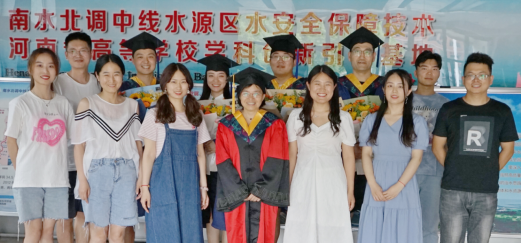Jiang, Y.; He, K.; Li, Y*.; Qin, M.; Cui, Z.; Zhang, Y.; Yao, Y.; Chen, X.; Deng, M.; Gray, A.; Li, B.; et al. Driving Factors of Total Organic Carbon in Danjiangkou Reservoir Using Generalized Additive Model. Water 2022, 14, 891. https://doi.org/ 10.3390/w14060891

第一作者:蒋叶青
通讯作者:李玉英
研究背景:南水北调工程是实现中国水资源优化配置、保障和改善民生的重大战略基础设施,是世界上最大的跨流域调水工程。总有机碳(total organic carbon,TOC)是全面反映水体含碳有机物污染程度的重要指标。TOC指溶解或悬浮在水中的有机物的碳含量(以质量浓度表示),包括溶解有机碳(dissolved organic
carbon,DOC)和颗粒有机碳(particulate organic carbon,POC)。TOC主要来源于浮游植物的光合作用、浮游生物的死亡和排泄物的降解、陆地有机物质的大量输入和湖泊沉积物的自然溶解等。它与人类的生态环境相互影响、相互制约。在检测方面,TOC具有速度快、精度高、产生危险废物少、不受潜在物质影响等优点,被认为是替代Biochemical Oxygen Demand(BOD)的一种水质指标。
研究方法:丹江口水库19个位点总有机碳浓度进行了季度性调查,探讨了丹江口水库TOC浓度的时空分布差异。并利用GAM模型分析了影响TOC浓度时空变化的主要驱动因子。
结论:(1)2020年5月-2021年1月丹江口水库TOC浓度介于0.29~7.10 mg/L之间,均值为3.77 mg/L。TOC浓度呈现较明显的时空分布差异,在时间尺度上表现为春季>夏季>秋季>冬季;在空间尺度上呈现出水口>汉库>入库口>丹库。
(2)单因素GAM模型分析中,TOC浓度的主要驱动因子因时间和生态区域而不同。时间上影响TOC浓度的主要环境因子秋季为WT、CODMn和NH3-N,但为冬季TN和SD。空间上影响TOC浓度的主要环境因子丹库为WT、COD、NH3-N、TN和Cond,汉库为WT、COD、NH3-N、TP和Chl.a。
(3)多因素GAM模型分析中,影响TOC浓度的环境因子主要为WT、Cond、TN、CODMn和TP,其中WT与Cond浓度呈显著的线性关系,TN、CODMn与TP浓度呈显著的非线性关系。
(4)丹江口水库水质整体处于中营养化状态,TOC浓度均值满足饮用水需求。
丹江口水库环境因子与TOC浓度的相关性分析
讨论:结果表明,丹江口水库各位点综合营养状态指数(Comprehensive trophic level index,TLI)为贫中营养状态,水质整体较好。TOC浓度在时间上整体表现为春夏季高、秋冬季低的特征,在空间上从大到小的趋势是出水口>汉库>入库口>丹库。TOC浓度与环境因子单因素GAM模型分析显示,影响TOC浓度的主要驱动因子在时空上具有显著差异。在时间尺度上,秋季为水温(WT)、高锰酸盐指数(CODMn)和氨氮(NH3-N),冬季为总氮(TN)和透明度(SD);在空间尺度上,丹库为WT、化学需氧量(COD)、NH3-N、TN和电导率(Cond),汉库为WT、COD、NH3-N、总磷(TP)和叶绿素a(Chl.a)。多因素GAM模型分析显示,影响TOC浓度的环境因子主要为WT、TN、Cond、CODMn和TP。其中WT和Cond与TOC浓度变化呈显著线性关系(edf=1,p<0.05),TN、CODMn和TP与TOC浓度变化浓度呈显著非线性关系(edf>1,p<0.05)。GAM模型可以较好地解释TOC浓度变化的主要驱动因子,可为丹江口水库水质评价及水库碳循环研究提供参考。
实验室介绍:河南省南水北调中线水源区流域生态安全国际联合实验室
(International Joint Laboratory of Watershed Ecological Security for Water Source Region of Middle Route Project of South-North Water Diversion in Henan Province)

开展针对南水北调中线水源区流域生态安全保护中面临的面源污染、水源涵养能力偏低、水资源利用效率效益不高等问题,积极探索国际化、多视角深层次合作。为南水北调后续工程高质量发展提供国际合作的科研平台,将为中线工程核心水源地生态环境保护提供良好的理论和实践基础,为确保“一渠清水永续北送”提供重要的技术支撑。
南水北调中线流域生态安全团队开展水生态、水环境、水质和水生态健康评价、生态修复和农业生态领域基础理论研究和技术开发,已在中线水源区取得了一定的成果,主持或参与国家级项目10多项,横向委托项目20多项,发表学术论文100多篇,授权专利20多项,专著8部;河南省科技进步奖二等奖1项,地厅级奖励6项。
Driving Factors of Total Organic Carbon in Danjiangkou Reservoir Using Generalized Additive Model
Abstract: Dynamic changes in total organic carbon (TOC) concentration in lakes and reservoirs affect the functions of aquatic ecosystems and are a key component of water quality management, especially in drinking water sources. The Danjiangkou Reservoir is the water source area of the Middle Route Project of the South-to-North Water Diversion in China. Its water quality is of critical importance to the safety of water diversion. TOC concentration and other environmental factors at 19 sampling sites in the Danjiangkou Reservoir were investigated quarterly during 2020–2021 to explore the differences at the spatio-temporal scales. A generalized additive model (GAM) was used to analyze the environmental factors correlated with the observed spatio-temporal variations of TOC concentration. The results showed that the comprehensive trophic level index (TLI) of the Danjiangkou Reservoir was under the state of intermediate nutrition, and the water quality was overall good. In terms of temporal patterns, TOC concentration was higher in both spring and summer and lower in other seasons. Spatially, TOC concentrations were found in descending order from the site of outlet, Han reservoir, entrance of reservoir, and Dan reservoir. The single-factor GAM model showed that TOC correlated with different environmental factors across spatio-temporal scales. Water temperature (WT), permanganate index (CODMn), and ammonia nitrogen (NH4+-N) were significantly correlated with TOC in autumn, but only total nitrogen (TN) and transparency (SD) were significant in winter. Spatially, WT, chemical oxygen demand (COD), NH4+-N, TN, and conductivity (Cond) correlated with TOC in the Dan reservoir, but WT, COD, NH4+-N, total phosphorus (TP), and chlorophyll a (Chl.a) were significant in the Han reservoir. The multi-factor GAM model indicated that the environmental factors correlated with TOC concentration were mainly WT, TN, Cond, CODMn, and TP, among which WT and Cond showed a significant linear relationship with TOC concentration (edf = 1, p < 0.05), while TN, CODMn, and TP had a significant nonlinear relationship with TOC concentration (edf > 1, p < 0.05). Comprehensive trophic level index (TLI) and TOC concentration revealed a highly significant correlation (R2 = 0.414, p < 0.001). Therefore, the GAM model could well explain the environmental factors associated with the spatio-temporal dynamics of TOC concentration, providing a reference for the evaluation of water quality and research on the carbon cycle in similar inland reservoirs.
Keywords: total organic carbon; driving factors; generalized additive model (GAM); large freshwater reservoir